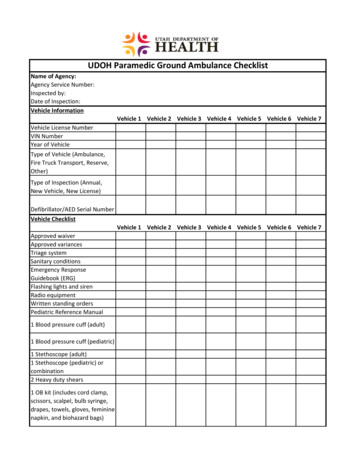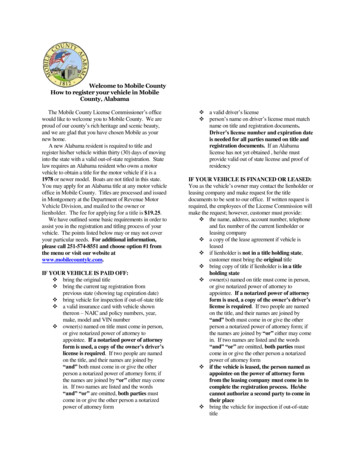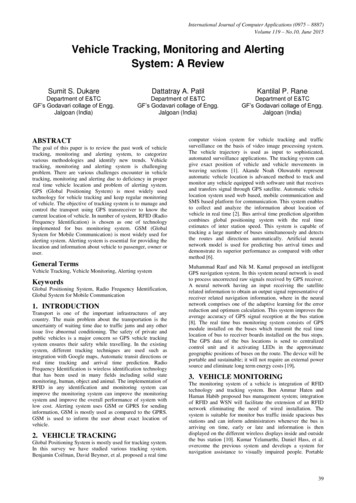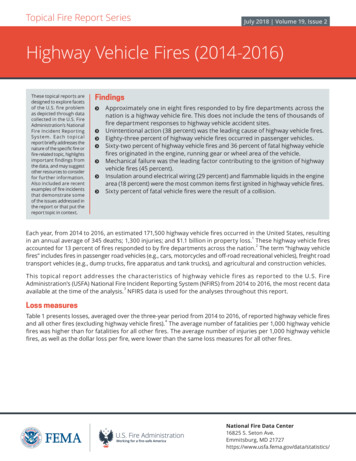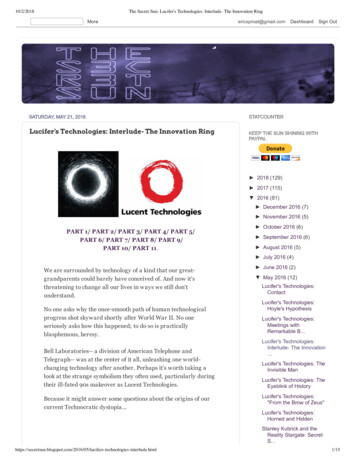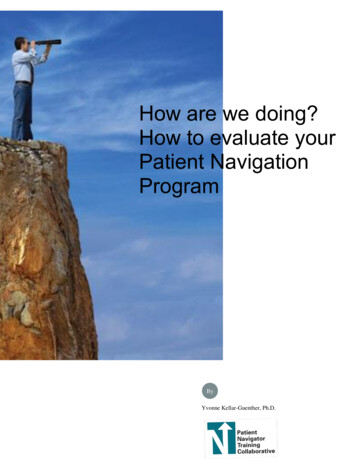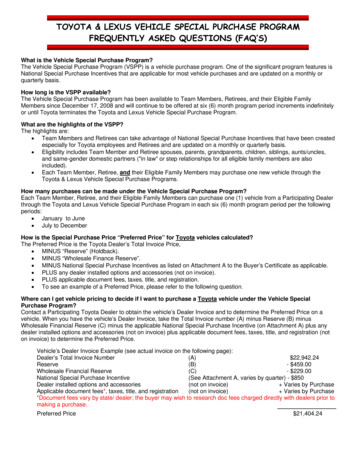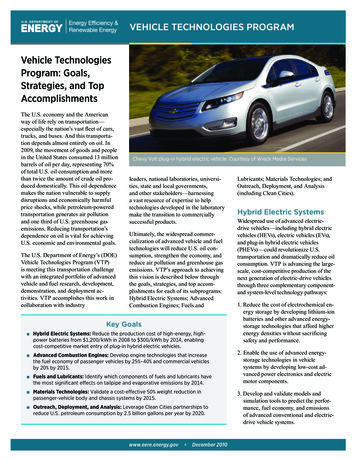
Transcription
VEHICLE TECHNOLOGIES PROGRAMVehicle TechnologiesProgram: Goals,Strategies, and TopAccomplishmentsThe U.S. economy and the Americanway of life rely on transportation—especially the nation’s vast fleet of cars,trucks, and buses. And this transportation depends almost entirely on oil. In2009, the movement of goods and peoplein the United States consumed 13 millionbarrels of oil per day, representing 70%of total U.S. oil consumption and morethan twice the amount of crude oil produced domestically. This oil dependencemakes the nation vulnerable to supplydisruptions and economically harmfulprice shocks, while petroleum-poweredtransportation generates air pollutionand one third of U.S. greenhouse gasemissions. Reducing transportation’sdependence on oil is vital for achievingU.S. economic and environmental goals.The U.S. Department of Energy’s (DOE)Vehicle Technologies Program (VTP)is meeting this transportation challengewith an integrated portfolio of advancedvehicle and fuel research, development,demonstration, and deployment activities. VTP accomplishes this work incollaboration with industryChevy Volt plug-in hybrid electric vehicle. Courtesy of Wieck Media Servicesleaders, national laboratories, universities, state and local governments,and other stakeholders—harnessinga vast resource of expertise to helptechnologies developed in the laboratorymake the transition to commerciallysuccessful products.Ultimately, the widespread commercialization of advanced vehicle and fueltechnologies will reduce U.S. oil consumption, strengthen the economy, andreduce air pollution and greenhouse gasemissions. VTP’s approach to achievingthis vision is described below throughthe goals, strategies, and top accomplishments for each of its subprograms:Hybrid Electric Systems; AdvancedCombustion Engines; Fuels andKey Goals Hybrid Electric Systems: Reduce the production cost of high-energy, highpower batteries from 1,200/kWh in 2008 to 300/kWh by 2014, enablingcost-competitive market entry of plug-in hybrid electric vehicles.Advanced Combustion Engines: Develop engine technologies that increasethe fuel economy of passenger vehicles by 25%–40% and commercial vehiclesby 20% by 2015.Fuels and Lubricants: Identify which components of fuels and lubricants havethe most significant effects on tailpipe and evaporative emissions by 2014.Materials Technologies: Validate a cost-effective 50% weight reduction inpassenger-vehicle body and chassis systems by 2015.Outreach, Deployment, and Analysis: Leverage Clean Cities partnerships toreduce U.S. petroleum consumption by 2.5 billion gallons per year by 2020.www.eere.energy.gov December 2010Lubricants; Materials Technologies; andOutreach, Deployment, and Analysis(including Clean Cities).Hybrid Electric SystemsWidespread use of advanced electricdrive vehicles—including hybrid electricvehicles (HEVs), electric vehicles (EVs),and plug-in hybrid electric vehicles(PHEVs)—could revolutionize U.S.transportation and dramatically reduce oilconsumption. VTP is advancing the largescale, cost-competitive production of thenext generation of electric-drive vehiclesthrough three complementary componentand system-level technology pathways:1. Reduce the cost of electrochemical energy storage by developing lithium-ionbatteries and other advanced energystorage technologies that afford higherenergy densities without sacrificingsafety and performance.2. Enable the use of advanced energystorage technologies in vehiclesystems by developing low-cost advanced power electronics and electricmotor components.3. Develop and validate models andsimulation tools to predict the performance, fuel economy, and emissionsof advanced conventional and electricdrive vehicle systems.
VEHICLE TECHNOLOGIES PROGRAM December 2010 Page 2One key goal is to reduce the productioncost of high-energy, high-power batteriesfrom 1,200/kWh in 2008 to 300/kWhby 2014, enabling cost-competitive marketentry of PHEVs. The following are someof VTP’s top Hybrid Electric Systemsaccomplishments to date.Jumpstarted the U.S. ElectricDrive IndustryVTP awarded 2.4 billion in funds fromthe American Recovery and Reinvestment Act of 2009 to new battery andelectric-drive component manufacturingand vehicle deployment projects. Theseinclude battery and power electronicsmanufacturing facilities, PHEV and EVdemonstration projects, and educationprojects. As the largest single investmentin these technologies, the awards willjumpstart the nation’s electric-drive manufacturing capacity and deploy more than13,000 vehicles and nearly 23,000 Level 2charging stations in residential, commercial, and public locations nationwide.Developed Today’s HEV andPHEV BatteriesVTP-sponsored research and development(R&D) resulted in the state-of-the-artnickel-metal-hydride batteries used inall of today’s HEVs. VTP also supportedJohnson Controls-Saft in developing thefirst lithium-ion battery incorporated intoa production HEV. In addition, GeneralMotors (GM) chose lithium-manganesespinel battery technology—developedby Compact Power/LG Chem with VTPsupport—for its Chevy Volt PHEV.Created World-Class Modeling ToolsIn 1999, VTP supported the development of the Powertrain Systems AnalysisToolkit (PSAT), which enables dynamicanalysis of vehicle performance andefficiency to support detailed design,development, and validation of vehiclecomponents and systems. PSAT becamethe primary vehicle model for all VTPactivities in addition to winning majorawards and being used by more than 130companies worldwide. In 2010, PSATevolved into an even more advanced tool,Autonomie, with significantly expandedcomponent and vehicle modeling, testing,and evaluation capabilities.Lithium-ion battery schematic. Courtesy ofArgonne National LaboratoryAdvanced CombustionEnginesAlthough internal combustion engineshave been used for more than a century,increasing engine efficiency is still oneof the most cost-effective approaches toreducing vehicle petroleum consumption and emissions. Integrating advancedengines with HEV and PHEV technologies provides even greater benefits. VTP’sstrategies for improving internal combustion engines focus on four complementarytechnology pathways:1. Increase the efficiency of internalcombustion engines for gasoline anddiesel passenger vehicles.2. Increase the efficiency of internalcombustion engines for commercialvehicles.3. Develop new combustion approachesthat are more efficient than dieselcombustion and produce near-zeroemissions.Johnson Controls-Saft lithium-ion battery.Courtesy of Johnson Controls-Saft4. Recover waste-heat energy from theengine’s exhaust to achieve a 10% orgreater efficiency improvement.One key goal is to develop, by 2015,engine technologies that increase the fueleconomy of passenger vehicles by 25%(for gasoline vehicles) to 40% (for dieselvehicles) and commercial vehicles by 20%SEITIC NAELC
VEHICLE TECHNOLOGIES PROGRAM December 2010 Page 3Analysis of a catalytic converter duringcold starting. Courtesy of Oak RidgeNational LaboratoryAdvanced laserdiagnostics of combustionin a modified Cumminsengine. Courtesy of SandiaNational Laboratoriescompared with 2010 baseline vehicles.A further goal is to increase commercialengine efficiency by 30% by 2018, withdemonstrations in commercial vehicleplatforms. The following are some ofVTP’s top Advanced Combustion Engineaccomplishments to date.Reaped a 60-Fold Returnon Commercial Engine R&DInvestmentsVTP-sponsored R&D enabled enginemanufacturers to improve diesel engineefficiency by 5% since 2002. To date, thishas saved 2.4 billion gallons of diesel fuelworth more than 7.6 billion—more than60 times VTP’s 123 million investmentin commercial engine R&D from 1999 to2007. The R&D also enabled engines tomeet 2007 regulations requiring a 90%reduction in particulate matter (PM)emissions and a more than 50% reductionin nitrogen oxides (NOx) emissions compared with the previous standards.Made Diesel as Clean as Gasolinefor Passenger VehiclesVTP-sponsored research demonstratedthe ability of diesel passenger vehicleswith advanced aftertreatment to meetstringent U.S. Environmental ProtectionAgency (EPA) emissions standards, spurring the current reintroduction of highlyefficient diesel vehicles into the passengervehicle market. Cummins partnered withVTP to develop diesel engine technologies that meet the 50-state 2010 emissionsstandards while boosting vehicle fueleconomy by 30% over comparablegasoline-powered vehicles. The advancedCummins engine is available on 2010Dodge pickup trucks.Fuels and LubricantsAdvanced vehicles require advanced fuelsand lubricants. VTP uses two complementary strategies to develop cleaner,greener fuels and lubricants for thevehicles of today and tomorrow:1. Develop nonconventional fuels andlubricants that maximize engine efficiency and minimize emissions.2. Test the impacts of nonconventionalfuels and lubricants on vehicle engines,emission-control systems, fuelinginfrastructure, and human health.One key goal is to identify which components of fuels and lubricants have themost significant effects on tailpipe andevaporative emissions by 2014. The following are some of VTP’s top Fuels andLubricants accomplishments to date.Evaluated Intermediate EthanolBlendsReaching 36 billion gallons of annualrenewable fuel consumption by 2022—as outlined by the Energy Independenceand Security Act of 2007—likely willrequire vehicles to use intermediateethanol blends such as E15 (15% ethanol,85% gasoline). VTP played a major rolein EPA’s October 2010 decision to permitE15 for model year 2007 and newer vehicles. Before intermediate blends could beapproved for use, their effects on the performance and emissions of vehicles andsmall non-road engines designed to runon gasoline with 0%–10% ethanol hadto be determined. VTP was the primarysource of information about the impactof intermediate blends, with researchfocusing on emissions, fuel economy, andvehicle driveability.Performed Research Resulting inMarket Shift to Ultra-low SulfurDiesel (ULSD)VTP led a government-industry collaboration in demonstrating that the sulfurcontent of diesel fuel had to be greatlyreduced to enable the use of advancedemission-reducing aftertreatment systems. Diesel vehicles require the use ofadvanced aftertreatment systems, suchas lean-NOx catalysts, to meet stringentemissions standards. VTP-sponsored research led EPA to require that all highwaydiesel fuel contain a maximum of 15-ppmSEITIC NAELC
VEHICLE TECHNOLOGIES PROGRAM December 2010 Page 4sulfur. Before this ruling went into effectin 2006, diesel fuel for on-road use contained an average of 350-ppm sulfur,with a legal maximum of 500 ppm.Instilled Confidence in BiodieselFuel QualityIn response to problems with the qualityof U.S. biodiesel arising in 2005, VTPpartnered with the National BiodieselBoard to improve ASTM (an internationalstandards organization) biodiesel fuelspecifications and ensure that suppliersadhere to the specifications. Surveys ofmarketed biodiesel conducted by VTP in2005 and 2007 showed a large improvement in compliance with the ASTMstandard over this period, including moreconsistent biodiesel concentration andreduced levels of impurities. The fuelquality improvement resulted in increasedwillingness among engine manufacturersto endorse biodiesel use in their engines.Materials TechnologiesOne way to improve a vehicle’s efficiencyis to make it lighter. Another way is topower it with high-efficiency propulsiontechnologies. Advanced materials play akey role in both these approaches. VTP isleading the development of high-performance, cost-effective materials—and theprocesses needed to manufacture them—to make advanced vehicles more efficientand affordable. These efforts focus onthree complementary strategies:1. Reduce the weight of body and chassiscomponents through use of advancedmaterials.2. Develop advanced engine and powertrain materials able to withstand highpressures and temperatures that enablemore efficient propulsion systems.3. Develop low-cost materials for electricmotors and drivetrain components.One key goal is to validate a costeffective 50% weight reduction inpassenger-vehicle body and chassis systems by 2015. The following are someof VTP’s top Materials Technologiesaccomplishments to date.Commercialized Advanced MaterialComponentsVTP collaborated with GM and Kaiser Aluminum to develop what wouldbecome GM’s “Quick Plastic Forming”process for manufacturing door components, lift gates, and various othercomponents. GM’s use of this process toreplace steel with aluminum componentshas produced per-part weight reductions of 35%. In addition, a joint projectbetween VTP and U.S. automakers overcame several barriers to the introductionof lightweight magnesium components,resulting in a magnesium engine cradlefor the Chevy Corvette Z06 that is nearly60% lighter than a steel cradle and 35%lighter than an aluminum cradle.Ultra-low sulfur diesel fueling pump label.Courtesy of American Petroleum InstituteDeveloped Materials Required forClean Diesel EnginesAs detailed above, VTP research led tothe commercial introduction of ULSDin 2006. ULSD enables the use of theadvanced aftertreatment devices that cutemissions from high-efficiency “cleandiesel” vehicles, but its reduced lubricity creates reliability concerns for somefuel-system components. To address theseconcerns, VTP coordinated developmentof improved zirconia-ceramic fuel injectorcomponents, which resist the wear ULSDcauses on injectors made of traditionalmaterials. Cummins, an engine manufacturer and project partner, subsequentlyintroduced zirconia-based timing, metering, and pumping plungers in the fuelinjectors of its mid-range diesel engines.Example of weight reduction through component design optimized for lightweight materials.Three photos courtesy of U.S. Department of Energy58% WeightReductionOriginal Design - Iron16 lb20% WeightReductionOriginal Design - Aluminum6.7 lbOptimized Design - Aluminum5.4 lbSEITIC NAELC
VEHICLE TECHNOLOGIES PROGRAM December 2010 Page 5Outreach, Deployment,and AnalysisVTP complements its R&D with outreach, deployment, and analysis thataccelerate the adoption and use of alternative fuels and advanced vehicles. Many ofthese efforts are part of VTP’s Clean Cities program. Clean Cities partners withstate and local organizations in the publicand private sectors to reduce petroleumuse through three strategies:1. Replace petroleum with alternativeand renewable fuels.2. Reduce petroleum consumption bypromoting smarter driving practices,idle reduction, and the use of morefuel-efficient vehicles and advancedtechnologies.The I-65 Biofuels Corridor.Courtesy of the IndianaOffice of Energy and DefenseDevelopment3. Eliminate petroleum use byencouraging the use of mass transit,trip elimination measures, andcongestion mitigation.Clean Cities’ overall goal is to reduceU.S. petroleum use by 2.5 billion gallons per year by 2020. Below are some ofVTP’s top Clean Cities accomplishments,as well as a description of VTP’s workto train the next generation of advancedtransportation experts.Displaced Nearly 3 Billion Gallons ofPetroleumClean Cities coalitions have reduced petroleum consumption by nearly 3 billiongasoline gallon equivalents (GGE) since1993 through local efforts like helpingschool districts run buses on biodiesel,working with truckers to install idlereduction equipment, and facilitating theadoption of alternative fuels by privateand government fleets. Clean Citiesefforts were responsible for more than700,000 of the AFVs on the country’sroads in 2009.Created Alternative Fuel CorridorsClean Cities helps place alternativefueling stations along major interstatecorridors. Today’s longest corridor keepsflexible fuel vehicle drivers always withinone-quarter tank of an E85 (85% ethanol,15% gasoline) station while travelingfrom the Great Lakes to the Gulf Coastalong I-65. Other E85 corridors includethe I-5 corridor in Oregon; the New YorkState Thruway; roads from Penn StateUniversity to Philadelphia; and the I95/I-64 Crescent Corridor, in Maryland,Washington, D.C., and Virginia. CleanCities has also helped California, Utah,and New York establish numerous naturalgas stations along heavily traveled routes.Brought the Fuel Economy Guide toMillions of Car BuyersThe Clean Cities/EPA Fuel EconomyGuide and its companion Web site www.fueleconomy.gov help consumers purchaseefficient cars and result in substantialpetroleum displacement—saving anestimated 131 million gallons in 2009alone. In a user-friendly format, the guideprovides fuel economy and emissionsratings, energy impact scores, and carbonfootprint information for all vehicles backto model year 1985, plus user-providedfuel economy statistics, calculators, andadditional consumer tools. It also can beaccessed from mobile phones and otherhandheld electronic devices.Spearheaded a Major Increase inAlternative Fuel Transit BusesFor more than a decade, Clean Citieshas helped deploy alternative fuel use intransit applications with great success.In 1996, only 4% of U.S. transit busesused alternative power. By 2008, nearly30% used alternative power, mostlycompressed or liquefied natural gas.Clean Cities coalitions brought more thanhalf these alternative fuel and advancedbuses to U.S. roads. The Natural GasSEITIC NAELC
PIX 12293VEHICLE TECHNOLOGIES PROGRAM December 2010 Page 6One type of alternativefuel transit bus promotedby Clean Cities.Credit: Leslie EudyTransit Users Group, led by Clean Cities,provides assistance to transit agenciesthat are considering or already operatingnatural gas buses.Trained the Next Generation ofEngineersVTP’s university-based activities develop a workforce of talented, trainedindividuals to help build the future U.S.automotive industry. Through the Graduate Automotive Technology Educationactivity, VTP funds eight universitiesto support graduate fellowships andestablish or enhance coursework towardgraduate engineering degrees that focuson a critical automotive technology. Student competitions—sponsored by VTPwith government, industry, and academicpartners—have given more than 16,000students hands-on experience in tacklingadvanced vehicle challenges. More than1,000 student competitors have gone onto automotive-related careers in government, academia, and industry.More InformationFor more information about the VehicleTechnologies Program, contact DrewRonneberg at Drew.Ronneberg@ee.doe.govStudents learningabout advanced vehicletechnologies as part ofthe EcoCAR engineeringcompetition. Courtesy ofEcoCARVehicle Technologies fora Better FutureIn an advanced vehicle, each componentis designed and optimized for superior individual performance. These componentsare then integrated in a way that maximizes the entire vehicle’s performance.The same paradigm holds true for DOE’sVTP. Each VTP subprogram focuseson specific goals, and the individualachievements are integrated to maximizethe speed and scope of VTP’s advancedtransportation progress.For example, a new battery technologyenables the development of advancedelectric-drive vehicles, which are designed and tested with powerful modelingtools, manufactured with governmentsupport, and deployed with the help ofClean Cities coalitions. Another R&DEERE Information Center1-877-EERE-INFO tereffort leads to the introduction of cleandiesel passenger vehicles, another provides the ULSD needed to run them, andyet another creates engine materials thatare more compatible with ULSD. Theseare just two of the many examples ofVTP’s successful integrated approach.VTP activities range in scale fromatoms to Class 8 tractor-trailers, and inmaturity from exploratory concepts tothe automobile dealership floor. Partners from industry, academia, nationallaboratories, and government lend theirsupport. This integrated, collaborativestrategy builds U.S. leadership in scienceand engineering while laying the necessary foundation of technologies—anddomestic technology manufacturers—for advanced transportation that willstrengthen the nation’s economic andenvironmental prosperity.DOE/GO-102010-3164 December 2010Printed with a renewable-source ink on paper containing at least 50% wastepaper,including 10% post consumer waste.SEITIC NAELC
Vehicle Technologies Program (VTP) is meeting this transportation challenge with an integrated portfolio of advanced vehicle and fuel research, development, demonstration, and deployment ac-tivities. VTP accomplishes this work in collaboration with industry Combustion Engines; Fuels and leaders, national laboratories, universi-ties, state and local governments, and other stakeholders .
